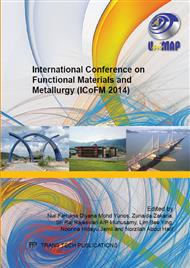p.81
p.87
p.91
p.97
p.103
p.109
p.117
p.123
p.129
The Effect of Applied Voltage and Anodisation Time on Anodized Aluminum Oxide Nanostructures
Abstract:
The use of anodized aluminum oxide (AAO) is vastly being explored in recent years. The application includes molecular separation, sensing, energy storage and template synthesis for various nanostructures. The reason AAO is preferred was because of the ability to control the nanopore structure by manipulating some factors during the anodisation process. This study will investigate the exploitation of voltage and anodisation time during the anodisation process and the effect it has on the nanopore structure of the AAO by examining the structure under Field Emission Scanning Electron Microscope (FE-SEM). The experiment was carried out by anodizing aluminum foil in 0.3 M oxalic acid as electrolyte under the constant temperature of 5 °C. The applied voltage was varied from 40, 60 and 100 V with different anodisation time. The outcome of this study demonstrates that applied voltage has a proportional relationship with the developed pore size. Increasing the applied voltage from 40 to 100 V had increased the pore size of the AAO from 38 nm to 186 nm, respectively. Aluminium oxide anodized at 60 V demonstrates pore size in the range of 76 nm. Prolong anodisation time had improved the pore morphology of anodized aluminium oxide in the case of 40 V, however, the pore wall starts to collapse when anodisation time is more than 4 minutes at 100 V.
Info:
Periodical:
Pages:
103-108
Citation:
Online since:
June 2015
Authors:
Keywords:
Price:
Сopyright:
© 2015 Trans Tech Publications Ltd. All Rights Reserved
Share:
Citation:


